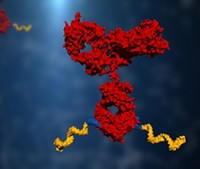Advertisement
Grab your lab coat. Let's get started
Welcome!
Welcome!
Create an account below to get 6 C&EN articles per month, receive newsletters and more - all free.
It seems this is your first time logging in online. Please enter the following information to continue.
As an ACS member you automatically get access to this site. All we need is few more details to create your reading experience.
Not you? Sign in with a different account.
Not you? Sign in with a different account.
ERROR 1
ERROR 1
ERROR 2
ERROR 2
ERROR 2
ERROR 2
ERROR 2
Password and Confirm password must match.
If you have an ACS member number, please enter it here so we can link this account to your membership. (optional)
ERROR 2
ACS values your privacy. By submitting your information, you are gaining access to C&EN and subscribing to our weekly newsletter. We use the information you provide to make your reading experience better, and we will never sell your data to third party members.
Start-ups
Intracellular biologics drug delivery start-up Entrada launches with $59 million
Firm is latest with plans to deliver proteins and nucleic acids inside cells using special peptides
by Ryan Cross
December 18, 2018

Many potentially great ideas for therapies never become a drug for a simple reason: they can’t get into cells. The cell’s protective phospholipid membrane blocks the entry of many antibodies, enzymes, and nucleic acids—collectively called biologics—that could treat a disease.
Now, a new Boston-based start-up called Entrada Therapeutics has raised $59 million in series A financing to develop and test a chemical technology to help deliver biologic drugs inside cells. Entrada’s most advanced program, still at the preclinical stage, is an intracellular enzyme replacement therapy for a genetic mitochondrial disease. The company also has programs using its delivery technology to get protein-protein interaction inhibitors and nucleic acids into cells.
Intracellular biologic delivery “is a field that’s been studied pretty aggressively over the past few years, but it’s also had its fair set of challenges,” Entrada CEO Dipal Doshi says.
One strategy for getting biologics into cells is to use cell-penetrating peptides (CPPs). These molecules, inspired by peptides found in nature, can be appended to proteins to help them cross cell membranes. “Cell-penetrating peptides have been around for a while” and have worked well on isolated cells grown in the lab, says Natarajan Sethuraman, Entrada’s chief scientific officer. Getting CPPs to work in humans, however, has been much more difficult.
First, CPPs are vulnerable to destruction by proteases, protein-chopping enzymes in the blood, Sethuraman says. Second, CPPs often get stuck in heparan sulfate polysaccharides in the extracellular matrix surrounding cells. Third, even if CPPs make it across the cell membrane, they often remain trapped in a compartment called the endosome and can’t get to the cell’s cytosol, where many drugs can exert their effects. “Those are all problems that Entrada’s technology solves,” Sethuraman says.
Entrada is developing CPPs based on the research of Ohio State University chemist Dehua Pei, a cofounder of the company. In 2012, Pei was studying the properties of CPPs to try to make cyclic peptides more permeable to cells. That research gave Pei another idea: make cyclic CPPs to move molecules across cell membranes. Amazingly, his CPPs traversed the membrane and then also escaped the endosome (Biochemistry 2014, DOI: 10.1021/bi5004102).
Since then, Pei’s lab has built a library of cyclic CPPs and elucidated a mechanism for how they might work. The cyclic structure helps the CPPs avoid destruction by protease. Using certain amino acids sequences—ones containing fewer arginines and hydrophobic amino acids—helps the CPPs avoid getting caught in heparan sulfate.
Most interestingly, the CPPs bind membrane phospholipids with low affinity at neutral pH but increase their affinity as pH drops in the acidic endosome. Pei showed that this high affinity increases the phospholipid membrane’s curvature, causing smaller vesicles containing the CPPs to bud off the endosome. The vesicles then disintegrate in the cell’s cytosol, releasing the CPP and the drug attached to it in the cell (Biochemistry 2016, DOI: 10.1021/acs.biochem.6b00226).
Advertisement
When the venture capital firm 5AM Ventures learned about Pei’s work two years ago, it decided to fund more research on CPPs in its in-house start-up incubator. The result was Entrada. For its first trick, the start-up plans on using CPPs to deliver needed enzymes that are either missing or dysfunctional in people with a genetic mitochondrial disease.
There are hundreds of mitochondrial diseases. Some of them could be treated by delivering a therapy into the cytosol. Others would require the additional hurdle of getting the therapy into the mitochondria, which itself is protected by a double membrane.
For now, Entrada is not divulging the disease target of its lead program, or saying whether the drug candidate will be delivered into the cytosol or into the mitochondria. Sethuraman says his team has demonstrated both approaches with its technology. Pei recently published a report on CPPs targeted to the mitochondria too (Angew. Chem., Int. Ed. 2018, DOI: 10.1002/anie.201811940).
Entrada isn’t the only start-up working on CPPs. Earlier this year, Feldan Therapeutics raised $13.8 million in its series A financing to develop a CPP technology for intracellular biologics delivery, including delivery of the Cas9 protein and guide RNA complex that compose the CRISPR gene editing system. Entrada doesn’t have plans to use CPPs for CRISPR delivery at this time, Sethuraman says, but the company is open to looking at all opportunities.
“This has the potential to be a game changing technology for something that is so important across different disease states,” Doshi says. “That’s the beauty of the platform. It’s very flexible.”



Join the conversation
Contact the reporter
Submit a Letter to the Editor for publication
Engage with us on Twitter